I miss my training
Thoughts
VII
I miss my training
Chazot
by Jean Luc Cornille
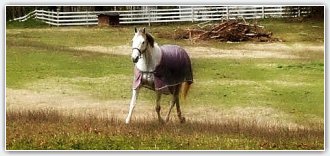
We truly enjoy the new place, large pastures, grass that tastes like grass, great weather, and very large stalls. We can literally trot from the window to the stall door. The windows open on a wooden area and now that the weather is nice, he leaves the window open all night. The other day we were watching a group of cattle running in the woods.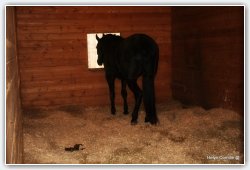 Manchester asked, do you know that the Canadian cattle are the fastest cows in the world? I confessed my ignorance in the matter. He added, when a patch of grass is forcing its way through the snow, the cows have to run like hell to reach the grass before it’s covered by the next snowstorm. I asked him, you know what it is said about German breeding? You tend to believe that you know all. Manchester responded, that is absolutely true but only for the riders.
Manchester asked, do you know that the Canadian cattle are the fastest cows in the world? I confessed my ignorance in the matter. He added, when a patch of grass is forcing its way through the snow, the cows have to run like hell to reach the grass before it’s covered by the next snowstorm. I asked him, you know what it is said about German breeding? You tend to believe that you know all. Manchester responded, that is absolutely true but only for the riders.
He told us when we arrived; hope you will love it because in the next few months I will have to sustain an extremely heavy clinic schedule in order to pay the bills. At first Manchester and I were considering the perspective of a nice vacation. Who could be happier? We are fed early in the morning. One hour later we are turned out. We come back at noon for lunch or we have lunch in the turnout if the weather is nice. We stay in the turnout eating grass, playing with each other and watching all of the activities until dark. We come back in the barn for dinner and we get another meal at the night check around 10pm. The training usually occurs in the morning, me first, and then Manchester. I was used to a regular schedule but as he told us, he is sustaining a very busy clinic schedule. 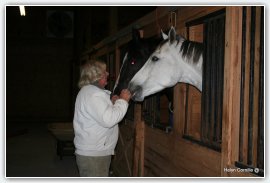 Not only he is gone every weekend, but he is also going away during the week. I hate when I see him all dressed up coming to say goodbye just before he drives to the airport.
Not only he is gone every weekend, but he is also going away during the week. I hate when I see him all dressed up coming to say goodbye just before he drives to the airport.
Helyn is doing her best to keep us in shape but she is also quite busy with her part of the business. I would never have imagined how much the regularity of our work was part of our physical and mental soundness. I sometimes paw with my foreleg on the cross ties while he is tacking me up. I discuss, resist, show impatience and strong opinion during my training session. I come back frustrated telling Manchester that he was a pain in the butt today, but I really miss all that. I could not imagine that one day I would say, I miss my daily training. I miss the physical part, the feeling of achieving greater control of my body and also that really good after-work feeling that I experience in the stall or back in turnout. Mentally, I miss the challenge. He makes me think all of the time and I do like this mental activity. I make plans just for the pleasure of contradicting equine neurophysiologists who state that we only have a short capacity of planning. I think about a better way to use my physique. When I see the red lights of his car leaving the property, I try to be interested by a dog passing in the next field or a kid running his bicycle on the road, but it is like my brain in going in standby mode. Like Donald Trump says, I am a very smart guy. However, I have to confess that when he was telling me about the man’s profile, I was thinking, if the guy is that smart, why does he want to become president?
On the racetrack, I enjoyed the respites, but rests were in fact healing periods before the next set of micro fractures and lactic acid imbalance. The racing industry believes in the afternoon nap. In large racing stables, there is no activity at all after lunch. We are supposed to rest and enjoy our nap. In fact we are all standing or lying in our stalls, letting our body heal from the damages of the morning work. Many of us get bored and annoyed by this lack of activity and physical discomfort and find something to do in the stall. I believe that this is why so many thoroughbred horses fall for addictive habits such as cribbing.
In fact we are all standing or lying in our stalls, letting our body heal from the damages of the morning work. Many of us get bored and annoyed by this lack of activity and physical discomfort and find something to do in the stall. I believe that this is why so many thoroughbred horses fall for addictive habits such as cribbing.
Muscles and bone actively remodel in response to changes in exercise. Response to mechanical stress is a fundamental feature of all living tissue. Recent studies have demonstrated that the real response of bone to exercise is to make more and to loose less bone. “The real response within bone organs subjected to mechanical overload exercise within normal physiological limits is to make more, and to lose less, bone.” (Alan Boyde, 2003) This is part of a very sophisticated repair mechanism that is occurring at different scales, down to the molecular level. “Recent advances in molecular biology have focused our attention on the importance of molecular factors in tissue development. Yet, there are other regulatory signals, such as mechanical stresses, that are equally critical for the control of tissue form and function. This is perhaps most evident in orthopedics where it is well known that muscles and bone actively remodel in response to changes in exercise.” (Christopher S. 1998) The ability of bone cells to work to produce bone seams in confined spaces is nothing less than wonderful. Such cementing capacity is optimal when we are under regular work.
An even more interesting finding is that the repair mechanism of cancellous bones is in preventing rather than curing damages. “In response to overload exercise in cancellous bones, damage is prevented rather than cured through infilling the prior marrow space compartment.” (Alan Boyde) In the study, the term overload should not be interpreted as excessive stress but rather increase stress remaining within normal physiological limits. One can refer to such overload a good stress.
New cells adapt to stress, and bringing a horse back to work after a rest period, involves the risk of inducing stresses for which the bone’s structure is not ready. I observed that each time I have to rest a few days for whatever reason, he restarts the training carefully; in hand the first day, the second day involves short periods of trot and long periods of walk and so on. At first, I was thinking that he was overly cautious. My energy level was high and I was ready for more. 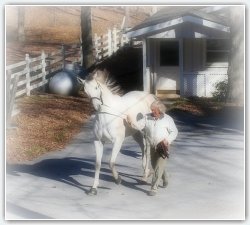 Manchester told me, I experienced the opposite. I was put back to work as if I had stopped working only the day before and believe me I spent very painful nights trying to cope with my aching body. Manchester’s remark reminded me of the deadly silence of the racetrack barn in the early part of the afternoon. Each one of us was standing or lying in the stall experiencing physical discomfort and even muscle aches. One day, I heard a vet telling to his assistant, they strain their muscles or overstress their bones in the morning and try to heal in the afternoon. The vet’s assistant was quite an attractive woman and I was thinking that the man was trying to impress her. Then, I moved toward the stall door to watch what they were doing and realized how much my back was hurting. From this day I gained respect for this vet. I wondered many times why he was not teaching our trainers to properly educate our physique instead of injecting us with all type of drugs. I realized then that the man was taking care of our problems because such was his job but his mind was in agreement with my thoughts, perhaps if trainers had the intellectual ethics to learn how our physique really functions, we would not have to deal with so many injuries.
Manchester told me, I experienced the opposite. I was put back to work as if I had stopped working only the day before and believe me I spent very painful nights trying to cope with my aching body. Manchester’s remark reminded me of the deadly silence of the racetrack barn in the early part of the afternoon. Each one of us was standing or lying in the stall experiencing physical discomfort and even muscle aches. One day, I heard a vet telling to his assistant, they strain their muscles or overstress their bones in the morning and try to heal in the afternoon. The vet’s assistant was quite an attractive woman and I was thinking that the man was trying to impress her. Then, I moved toward the stall door to watch what they were doing and realized how much my back was hurting. From this day I gained respect for this vet. I wondered many times why he was not teaching our trainers to properly educate our physique instead of injecting us with all type of drugs. I realized then that the man was taking care of our problems because such was his job but his mind was in agreement with my thoughts, perhaps if trainers had the intellectual ethics to learn how our physique really functions, we would not have to deal with so many injuries.
At the level of our bone structure, we are simultaneously strong and fragile. Unless we are brought back to work progressively after a rest period, the risk of microcracks is real. In most instances our physical nature is capable to bandage the problem. You need to understand that I am not talking about a band-aid but rather a repair mechanism that is adding layers to fill the cracks. However, dramatic consequences are possible. “We have shown that the common distal condylar fractures of the equine third metacarpal (cannon) bones begin by the process of cracking in articular calcified cartilage, which is usually focused in the depths of the condylar grooves.” (Riggs CM, 1999)
Talking about cartilage, the leading edge in the research is now exploring the thought that cartilage issues originate from abnormal stresses on the bones. “It is now generally accepted that osteoarthritis onset and progression are mediated largely through biomechanical forces acting across the joint and failed repair of damage caused by excessive mechanical stresses and loading on joint tissues.” (Craig Waller, 2011) This specific study was made for humans, but the same thought is now growing in the corridor of equine research studies. All type of drugs are injected on articular cartilage but as long as the stresses overloading the bones are not addressed more and more injection will be necessary. “It has been postulated that the long standing inability to effectively alter damage in knee osteoarthritis with the current therapeutic paradigm is the result of a persistent overemphasis on articular cartilage as the primary outcome of joint failure This myopia has been misdirected and fails to address the root cause of the disease.” (Craig Waller and all)
I heard him telling to a student, I never have to inject any horse hock or stifle, even with horses who are coming with so-called hock problems, because I focus on recreating proper kinematics of the limbs and therefore normal stresses on the joints.
During one of the sessions of quality time together that he and I are having just for the sake of having quality time together, he was reading a fascinating study about the chemistry of our muscular system. The title catches my attention, Lactate: metabolic fuel or poison for racehorses? Everybody knows about lactic acid. Lactate, feeds our muscles for work, however excess of it does cause soreness and even tying up. It is fascinating for me to learn why I feel what I feel. I guess it must be useful for him to understand how our body works in order to better prepare our physique for the performances.
Basically, the study focused on two transporters that are involved in the chemical balance of our muscular system. One, referred to as MCT1, is primarily involved in facilitating the extraction of lactate from the extracellular fluid. The other, MCT4 primarily facilitates the next efflux of lactate. Lactate is a metabolic fuel for muscle performance. However, “excessive accumulation of lactate within muscle contributes to intercellular acidosis and fatigue” (Cains, 2006) Performances can be enhanced when muscles improve their ability to remove lactate from within contracting cells. “What is important is that these characteristics are enhanced with appropriated training.” (Michael I. Linger, 2011)
Sometime I look at relatively young riders wearing large spurs and I wonder how can they look so young and be in fact so old. He explained me that they do not have necessary the age of the theories they apply. Under the name of tradition, young riders are perpetuating old ideas. His mind was now on the subject and I listened carefully since even when he thinks, he does have an accent. Since you are talking about the spurs, look at the beliefs behind the theoretical effect of the spurs. Long time ago, when the studies of equine anatomy were in their infancy, the thought was that the touch of the rider’s legs or spurs, was contracting muscles engaging the hind legs. It was discovered later, that the rectus abdominis, which are the muscles activated by the rider legs and spurs, do not engage the hind legs. The relation between the touch of the rider’s legs and the activity of the horse’s hind legs occurs at the level of sensors which convey the perception of the rider’s touch onto the horse’s brain. Sensors feeling touch are spread all over the horse’s body. They are the sensors that feel a fly. Via sensory pathways, the perception is directed to the brain. The touch is compared in the memory with previously stored stimulus Once the memory identifies the meaning of the touch, (conditioned reflex,) the cerebral cortex decides the response. The response is then adjusted to the body coordination. Any muscle imbalance, protective reflex contraction, morphological flaw, or other abnormality will determine spontaneous response or resistance, straightness or crookedness, etc. For instance, as today, your back muscles are no longer painful. Your response to the touch of my legs is to move forward. By contrast, during your racing career, your response to the jockey’s stimulus was to rear straight up in the air.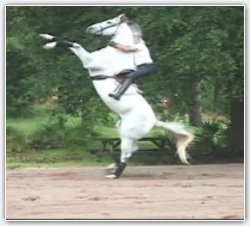 The stimulus was conveyed onto your brain through the same sensory pathways. Your memory recognized the meaning of the stimulus as well as today, but the elements of your brain monitoring your body were aware of pain in your back muscles and your decision was defensive. Your original response was legitimate. What was less legitimate was that you soon realized that rearing very high allowed you to get rid of the rider and you elected to rear all the time. This, my dear does not have any scientific explanation other than you are a magisterial pain in the behind.
The stimulus was conveyed onto your brain through the same sensory pathways. Your memory recognized the meaning of the stimulus as well as today, but the elements of your brain monitoring your body were aware of pain in your back muscles and your decision was defensive. Your original response was legitimate. What was less legitimate was that you soon realized that rearing very high allowed you to get rid of the rider and you elected to rear all the time. This, my dear does not have any scientific explanation other than you are a magisterial pain in the behind.
Many so called behavior issues are in fact protective reflex mechanisms. The mind of a horse improperly coordinated may associate forward motion and physical discomfort. The response to the rider’s legs may then be resistance, late departure, or more subtle faults. If the rider is not knowledgeable enough to think beyond the stereotypes of obedience and submission, reluctance to forward motion may be interpreted as laziness, stubbornness, or attitude problem.
Look at yourself. When you express your difficulties with right lateral bending, it is my job to figure the insights that could ease the effort. In the matter, greater understanding of your vertebral column mechanism does facilitate my thought process. Your job is then to process the best response. Our respective intelligences are working at their own levels. I provide the rational analysis and you process the most efficient coordination. Honoré de Balzac wrote, “Friendships last when each friend thinks he has a slight superiority over the other.” As long as you think that you are smarter than me and I know that I am a little cleverer than you, our friendship is safe.
Further researches suggested greater sophistication of your muscular system. Knowledge also introduced the need for more subtle riding and training principles. Estienne Saurel wrote, “Undoubtedly any shift of the rider’s weight is important for balancing the horse for controlled movements.” (Estienne Saurel. !964) In the light of the back muscles’ architecture and function as we know it today, any shift of the rider weight is at the contrary, altering your ability to properly coordinate your back muscles. The refinement of your vertebral column mechanism demands sophisticated control of the rider’s vertebral column movements. Waldemar Seunig proposed a coordination of the rider’s back adapted to actual knowledge of the equine vertebral column mechanism. “The subtle S-curve of the spine allows the spine to oscillate minutely, a movement so tiny that it is hardly perceptible to the naked eye, producing a ‘soft’ seat. This ‘soft seat’ differs fundamentally from a ‘doughy’ seat, in which we find a spine that is too flexible and allowed to undulate freely in response to the horse’s movement.”
Today researches are about the chemical transformations stimulating muscle cells’ contractions. Even at this level, proper functioning relates to regular work “Mechanical stresses that are applied to the whole organism are transmitted to individual cells and transduced into a biochemical response.” (Christopher S. and all, 1998) Your muscular system operates at a totally different level that previously believed. The thought that the rider stimulates muscles that are moving your bones is so primitive that it does not even relate to the horse’s biological mechanism. The minute oscillations of the rider’s vertebral column described by Waldemar Seunig, are primarily a body language through which we, as riders, are able to guide your brain toward athletic coordination eminently adapted to the physical demand of the performance. This is not about refining natural reflexes but rather creating reflex combination beyond the scope of natural reflexes.
Manchester entered then the discussion. I know first hand how beneficial the practical application of pertinent research studies can be. But I also know first hand how detrimental theories based on fake science can be. The label “scientifically demonstrated,” is often used to accredit theories without any scientific back ground. Some of these theories have been applied to me. The cocktail, ‘a little bit of science and a lot of imagination’, is scary. I was listening to these ‘would be experts’ talking about my progress and wondered what progress they could possibly be talking about. They were placing their hands in strange positions, executed some mystical shifts of their body weight on the saddle describing how my back muscles were working. Some were so persuasive that I wondered if I had shut off all my sensory pathways. I never felt anything resembling even vaguely to what they were describing.
His mind remained on how our muscular system operates.  He was thinking about Chistopher S’s study, “Changing muscular tone can alter mechanical stability and structural coordination throughout the whole musculoskeletal system.” (Christopher S and all, 1998). The thought brought him back decades earlier. When I was preparing my horses for three day event competitions, especially for what is called today the long format, it was a constant struggle finding the balance between production and elimination of lactic acid. We did not have the knowledge available today. We did the best we could but in the light of new knowledge I realize that we could have done much better. In fact, it was at this time a phenomenon commonly referred to as (Monday sickness). The horses were normally resting on Sunday and tying up was more frequent on Monday, which was the day after resting. Any day off was dangerous and we were riding every day the horses that were particularly fit. I can see now where his concerns for regular training come from and even if our education is not about high speed, I can feel in my body that I am not muscularly as comfortable as I was when his schedule allowed him to keep me on regular physical work.
He was thinking about Chistopher S’s study, “Changing muscular tone can alter mechanical stability and structural coordination throughout the whole musculoskeletal system.” (Christopher S and all, 1998). The thought brought him back decades earlier. When I was preparing my horses for three day event competitions, especially for what is called today the long format, it was a constant struggle finding the balance between production and elimination of lactic acid. We did not have the knowledge available today. We did the best we could but in the light of new knowledge I realize that we could have done much better. In fact, it was at this time a phenomenon commonly referred to as (Monday sickness). The horses were normally resting on Sunday and tying up was more frequent on Monday, which was the day after resting. Any day off was dangerous and we were riding every day the horses that were particularly fit. I can see now where his concerns for regular training come from and even if our education is not about high speed, I can feel in my body that I am not muscularly as comfortable as I was when his schedule allowed him to keep me on regular physical work.
Another day, he was reading a book entitled, 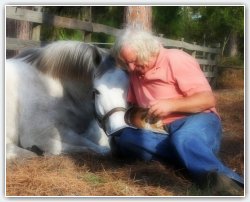 How We Decide by Jonah Lehrer. The author explains that while decisions are created in the cerebral cortex, a great part of any decision is influenced by emotions. In our world, emotions are intimately related to physical comfort or discomfort. If our body aches, our mind worries. Conversely physical comfort eases our mental intensity. I have observed that without really wanting it, I was spookier than average. I was also less patient and quicker to worry. I do miss my regular training. He told me, I do too. Hang on; the situation will stabilize soon. As you know, I have to have the last word so I will say, not soon enough.
How We Decide by Jonah Lehrer. The author explains that while decisions are created in the cerebral cortex, a great part of any decision is influenced by emotions. In our world, emotions are intimately related to physical comfort or discomfort. If our body aches, our mind worries. Conversely physical comfort eases our mental intensity. I have observed that without really wanting it, I was spookier than average. I was also less patient and quicker to worry. I do miss my regular training. He told me, I do too. Hang on; the situation will stabilize soon. As you know, I have to have the last word so I will say, not soon enough.
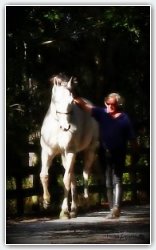
Chazot and Jean Luc Cornille
References
(Alan Boyde, The real response of bone to exercise, Department of Anatomy and Developmental biology, University college, London Uk. J. Anat, 2003. pp173-189)
(Riggs CM, Whitehouse GH Boyde Alan, 1999b, Pathology of the distal condyles of the third Metacarpal and third Metatarsal bones Equine vet. J. 31, 140-148)
(Cains SP, 2006, Lactic acid and exercise performance culprit or friend? Sport Med. 36, 279-291)
(Michael I. Linger Lactate: metabolic fuel or poison for racehorses?2011)





